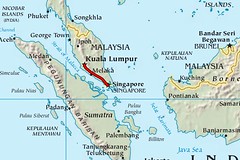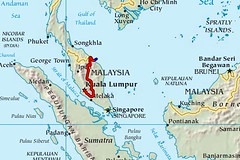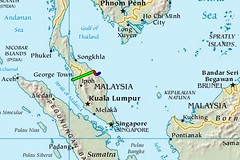Singapore slingshot
When we checked into our hotel in Kuala Lumpur we noticed a flyer at reception advertising Aeroline, a bus company offering a luxury coach from KL to Singapore. When we looked at the service they promised, and the prices, we didn't bother shopping around for alternatives. We booked online and turned up at the pick up point, the Corus Hotel near KLCC LRT station, at 07:15 for our 08:00 departure.
The service was excellent—exactly as advertised with a baguette for brunch, drinks on demand, a power point at the seat, the most smiley, helpful staff we've ever met, and a very professional driver. We had booked at the last minute and the only seats available were on the back row. Our fellow passengers were from all walks of life. The man in front of us in a shiny grey suit could easily have been Korean; up front were a middle aged, white American couple; an extended family of Indians occupied the middle of the bus, and took their time disembarking and rejoining us at each border post.
Border formalities at either end of the 'Second Link' causeway separating Malaysia and Singapore were straightforward. As ever it took a bit of time to get everyone through the passport checks and back on the bus, but we arrived ahead of schedule at the Harbour Front in Singapore.
To get to our hostel we had to find the nearest subway station. To get to the subway we had to walk through a mall. We soon found that to get anywhere in Singapore you have to walk through a mall. This is because Singapore is basically a series of malls linked together by little pieces of city.
If you've heard anything about Singapore you've probably heard that it's clean and safe. This is true. Maintaining this infeasible level of cleanliness and safety isn't easy though, and it is accomplished by having rules. Lots of rules, strictly enforced. Rule breakers are fined, heavily. Persistent rule breakers are presumably executed. On top of the national rules, each building implements its own local rules. Our hostel, home for the next four days, had rules posted everywhere. Here are the ones we can remember, along with associated fines:
- Breakfast is between 6 and 10am. Outside this time you pay S$1. People caught stealing breakfast without paying will be fined S$50.
- No eating on the sofa. Fine S$100.
- No food or drink in your room. Fine S$100.
- Guests must leave by 9pm. Trespassers will be handed to the police.
- No shitting on the floor. Fine S$500.
Assuming the last one isn't a joke, it means someone probably did that once. In which case we don't begrudge them that rule! Western backpackers can be a vile lot, and we wouldn't relish trying to maintain a Singaporean standard of cleanliness in a backpacker hostel. Actually, we wouldn't try. Unfortunately the task is so herculean that the hostel owner seemed really pissed off most of the time.
We did quite a lot during our short stay in Singapore. We walked the nearly-finished track of the upcoming Singapore Grand Prix. When it's on TV in September watch out for the bit which goes over the Anderson Bridge—it looked scarily narrow to us. We went to the Long Bar in Raffles Hotel for a Singapore Sling in surprisingly laid back and non-touristy surrounding. We shopped and we ate. Actually shopping and eating are Singaporeans' two favourite pastimes. Food courts offer cheap meals from every corner of Asia, and much of the rest of the world. We even saw a British chip shop selling deep fried Mars bars. If food is the national hobby, shopping is the state religion. Malls tower, cathedral like, over the city; their gleaming domes and marbled atria filled with the devoted making their weary pilgrimage from shrine to retail shrine. Shopping is not, never has been, and never will be a pleasure to us. We find it incomprehensible. Does spending too much money make people happier? Does owning this season's ridiculous 'designer' objects fill a need? It made us sick after a few days.
In Singapore we did actually need to shop for a few things. Glenn's shoes never had much grip on the soles, but we've walked so much he's worn them totally flat. We've also both worn out a pair of socks. So we fixed both of those problems.
Also, there is some sad news. Since we started back out on the road from Seoul we have struggled to fit everything into our tiny bags and they have become too heavy. The addition of another laptop, to add to the one we bought fairly early on our trip, a pair of flip-flops and set of swimwear and beach towels each and a couple of extra t-shirts for Glenn had the old bags bursting at the seams. So, we've bitten the bullet and bought proper backpacks. They're not the huge ones that we've been so scathing of throughout our trip. Isla's is 38 litres and is sold as a day pack, and Glenn's is a little bigger at 50 litres and quoted as an overnight bag (he's bigger, so it's fair). We now have plenty of extra space for whatever we need for a particular country. This means we can keep the beach towels we bought in the Perhentian islands until after we leave beachy places and when we move from the tropics back to cooler climes we'll be able to buy a jumper or coat without having to wear it all the time. Our little day bag can go back to travelling inside one of our main bags so we're much more streamlined when we transit. We know it makes sense, but it's still a disappointment that we couldn't keep to our original plan of using truly tiny bags.
On day three we went to the zoo. Singapore zoo is cleverly engineered so that a lot of the time you're hardly aware of being physically separated from the animals. Orang utans roam freely in the trees above your head and can travel a long way outside their moat, but it's designed so that they can't climb down until they go back to their own area. We had a recommendation from a friend to visit the zoo for their Jungle Breakfast. We followed this up and phoned ahead the day before to book our table. Before breakfast we watched two elephants take their morning bath and snack on bananas. Then we went to satisfy our own hungry tummies. Half way through the meal, we were joined by Miri the Orang utan and her three month old baby, Ah Tseng. Miri was persuaded to sit patiently by a seemingly endless supply of fruit, while tourists oohed and aahed at her, and queued for a closer look and a photograph.
By lunchtime we were flagging in the equatorial heat. The eco-conscious zoo doesn't seem to have any air-conditioned places to provide respite—maybe it knows that if it did they're be swamped by sweaty westerners. We'd seen almost everything we wanted to see, so we trudged back to the bus stop and the delicious coolness of Singaporean public transport (London Underground take note).
We had one final purchase to make before leaving Singapore and her malls. Tomorrow we hop back into a malaria-risk area with a flight from Johor Bharu (just across the Malaysian border) to Kuching in Sarawak, the western state of Malaysian Borneo. So as of tonight we're back on the Malarone. We still have a few of our original UK batch left, and all the ones we bought in Hong Kong, but we felt it made sense to top up while we could.
You can buy Malarone in Singapore without a prescription, if you go into a large pharmacy and present your (non-Singaporean) passport and an air ticket to a malarial area. You have to wait until the day before you fly out. You also have to present a large wad of cash. The price is S$7 per tablet, S$92.40 per box of twelve (GBP 34.21 / USD 67.47). When you can eat a sumptuous dinner for less than S$6 that stings! We don't know what the limit is—the pharmacist didn't blink when we asked for three boxes in Isla's name, so we could have bought twice that if we wanted to, and probably more. We don't know whether you can do this at all pharmacies but as of July 2008 you can definitely buy Malarone in Singapore, over the counter at Watsons. We used the large branch in the basement of Ngee Ann City mall on Orchard Road.
So what did we think of Singapore? It's similar to our favourite city Hong Kong, and very easy to get around in, especially since everything is written in English first. But to be honest the obsessive rules got to us. We were continually worried, for example: we've just bought a sandwich from the Seven-Eleven. Can we eat it in that park over there? Are we even allowed to walk on the grass? Or will we be dragged away and flogged? We think that the reason Singapore doesn't have much crime is because everyone's head is so full of rules, they don't have any mental capacity left over for doing bad things. A crime-free society comes at a hefty price.
Day 612
Kuala Lumpur to Singapore
This map shows the route we took in this post. Click it to see larger maps of our whole route at flickr.
Maps are taken from the CIA World Factbook.


![[IMG_4602]](http://farm4.static.flickr.com/3090/2723404991_72e82379fb_m.jpg)
![In the Long Bar at Raffles Hotel, of course. Horrific price but it had to be done. [IMG_4641]](http://farm4.static.flickr.com/3266/2723581141_05bacb85f5_m.jpg)
![Roaming the tree tops at Singapore zoo. [IMG_4676]](http://farm4.static.flickr.com/3105/2724573652_61e2ac6931_m.jpg)

![[IMG_4598]](http://farm4.static.flickr.com/3116/2721519686_82194bae39_m.jpg)
![Because we failed to eat Taiwanese food in Taiwan we decided to try it in Kuala Lumpur. [IMG_4599]](http://farm4.static.flickr.com/3002/2724211284_a3cdf8acea_m.jpg)
![[IMG_4582]](http://farm4.static.flickr.com/3255/2715988687_4e42bdc7a3_m.jpg)
![Kota Bharu. [IMG_4581]](http://farm4.static.flickr.com/3184/2697862229_59222008d5_m.jpg)
![Seen from the Jungle Line train. [IMG_4590]](http://farm4.static.flickr.com/3257/2720633335_4b0f5afea3_m.jpg)

![[IMG_2243]](http://farm4.static.flickr.com/3046/2691454925_9c772fd1a0_m.jpg)
![Nemos never stay still. [IMG_2207]](http://farm4.static.flickr.com/3167/2692240894_bbdb4187cd_m.jpg)
![[IMG_2215]](http://farm4.static.flickr.com/3250/2691454885_ca504104a3_m.jpg)
![The main way to get around on Perhentian. [IMG_4552]](http://farm4.static.flickr.com/3204/2691265127_e947935379_m.jpg)
![[IMG_4558]](http://farm4.static.flickr.com/3215/2692103942_e4494ca17f_m.jpg)



